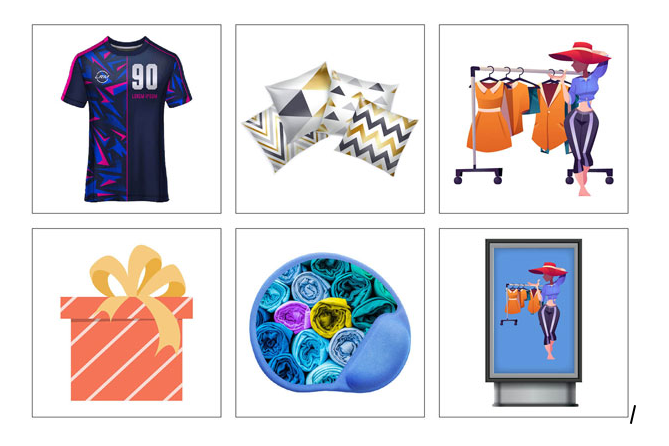31
Jul
Are you going to start a printing business? Well, that’s rewarding. We know many different types of printing machines are trending in the market, but have you heard about the most popular sublimation printing? If not, no worries. In this article, we will share complete details about sublimation printing, covering its consumables, applications, pros, and cons. So keep learning!
Checklist
What is sublimation printing?
What are the consumables for sublimation printing?
What are the applications of sublimation printing?
What are the pros and cons of sublimation printing?
Conclusion

“Sublimation printing is a well-known method of transferring designs onto different materials, such as cloth, plastic, ceramic, etc., using heat and pressure.”
The working mechanism of sublimation is very simple and quick. So. let’s take a look at how it works:
Step 1) First, you design your graphic on a computer using graphic design software ( Photoshop, Illustrator, etc).
Step 2) The design is printed using sublimation ink on a special sublimation paper.
Step 3) The finished print ( sublimation papers ) is then placed on the object to be decorated ( for instance, a T-shirt or mug ). Then, it is passed through a heat press machine.
Step 4) Once the heat press turns on, it heats up both the sheet and the material. As a result, the sublimation ink becomes vapour because of intense heat, and then it penetrates the material surfaces. This puts down an image inside of something other than just laying it on top of the surface.
The outcome is a long-lasting, high-quality print that will never fade, crack, or peel off. Moreover, when applied to polyester fabrics and polymer-coated things, sublimation prints have better results.
So let me talk about every single material that is used in this whole set up of sublimation printing, which is made up of several components that work together to give you a very magical outcome;
i) Sublimation Printer: They have been made only for use with sublimation inks to perform good prints. Furthermore, they play an integral part in ensuring ink’s right transfer and brightness.
ii) Sublimation Ink: Unlike other paints used for art or photo printing, which first become liquid and then evaporate, sublimation ink changes directly into the gaseous state from the solid phase without going through any intermediate stage. Therefore, when it comes to high-quality image production, durability, and accurate color match, one cannot do without it.
iii) Heat Press: It’s a machine that applies the appropriate combination of heat and pressure to transfer the sublimation ink from the paper (on which it was printed) to the substrate (upon which it will finally be located). Moreover, heat presses come in various sizes and models corresponding to different types of substrates.
iv) Protective Paper: Some sort of protective barrier, such as butcher or parchment paper, should be used while transferring to avoid any streaks or unwanted marks on the heat press.
v) Heat Tape: Heat tape holds your design on top of the substrate while transferring ( by preventing shifts caused by the heat process ); this kind of tape can withstand very high temperatures, thus ensuring precision and cleanliness.
Sublimation printing has been used in various fields and industries for a variety of purposes, such as
Clothing and Apparel: It has already become popular in the fashion industry, where you can make customized t-shirts, jerseys, and hoodies. In addition, sublimation printing involves ink that bonds better with polyester fabric than other materials, resulting in brighter colours that do not wash out even after repeated laundering periods.

Home Decor: These items include cushions, blankets, curtains and tablecloths, which can be customized through sublimation printing to produce detailed designs and vibrant colors that give a personal touch to home interiors.
Personalized Gifts: Sublimation printing is common for making customized gifts such as photo frames, mugs, key chains, phone cases, picture names, or special messages.
Promotional Products: Materials such as sublimated printed mugs or even mouse pads can be given as promotional items, among others, like custom coasters and tote bags, usually at conferences/trade fairs, where they increase visibility and raise your brand recognition.
Signage & Banners – Sublimation printing can create high-quality indoor/outdoor signage. Also, apart from this aspect, their longevity makes these prints suitable for advertisement purposes, including events, displays, etc.
Photo Printing: You can use sublimation printing techniques in order to create high-quality pictures of objects like tiles, puzzles, and metal panels.
Textiles & Fabrics: Sublimation printing is used for flag production, bandanas, and other things like clothes, rather than traditional screen-printing technologies that are available today.
Although there are several advantages to popular sublimation printing, there are some limitations associated with it; there is a quick rundown:
Pros:
+ Vivid Colors: Sublimated prints come out very bright with full-colour precision in details, especially on sportswear, such as jerseys with sharp team logos and player names, making them professional and conspicuous.
+ Durability: Luckily, sublimation prints do not fade, peel, or crack easily and can last a long time. You can use sublimation-printed objects repeatedly without compromising their overall appearance.
+ Full-Color Printing: You do not have to pay extra for multicolored complex designs. This method can be used to print phone cases and promotional banners
+ All-Over Printing: Sublimation ensures that your materials have no seams, thus facilitating full-coverage designs. Customized t-shirts with front and back designs are great examples of such items.
+ No Feel: The design doesn’t feel raised since it is embedded into the material; just like your ordinary blankets, these personalised ones remain soft when touched.
Cons:
- Material Limitations: It can only work with 100% polyester fabric. If you have some other material, you must coat it with a poly-coating.
- Initial Cost: Sublimation printers and heat presses are expensive, and their cost might discourage small businesses from starting up.
- Colour Limitations: The process employed here could lose colour accuracy, which does not guarantee the perfect reproduction of brand-specific shades.
- Heat Sensitivity: For every print run, the correct settings should be followed by implementing the exact temperature requirements needed. Otherwise, the outcome may look bad due to too much or too little heat being applied at the right pressure, which makes it smear, ghost, and blur.
In short, sublimation printing can be a bit extensive in the beginning, but in the long term, its durable, soft, vivid, and embedded prints can make your profits grow a lot. Besides this, before investing in this project, think carefully about the model, size, and technology of sublimation printers.
If you are still unsure, contact us with your project details, and we will give you free advice. Plus, we at Fedar have been manufacturing Sublimation printers since 2001, which you can buy from us at budget-friendly prices.

